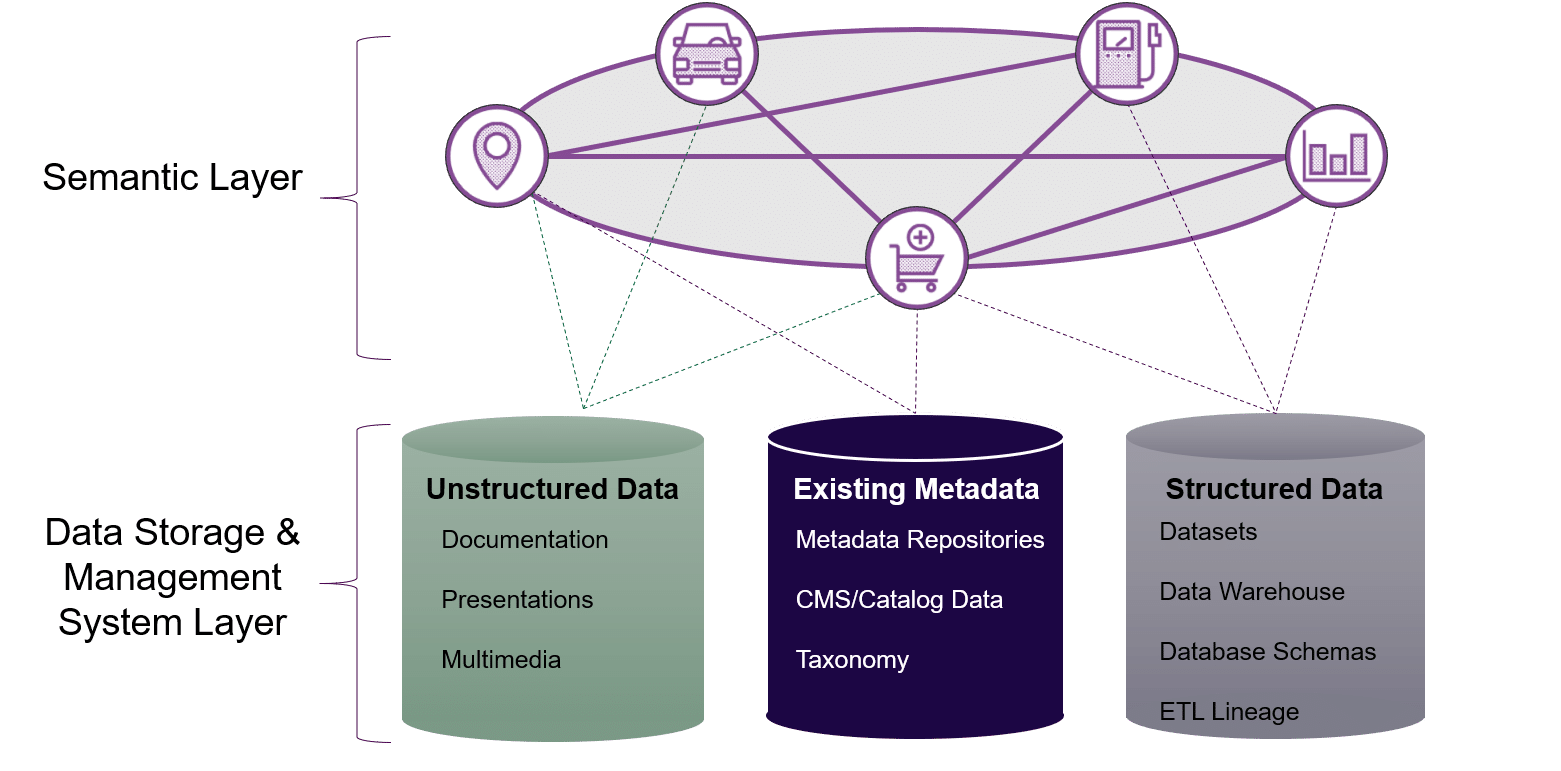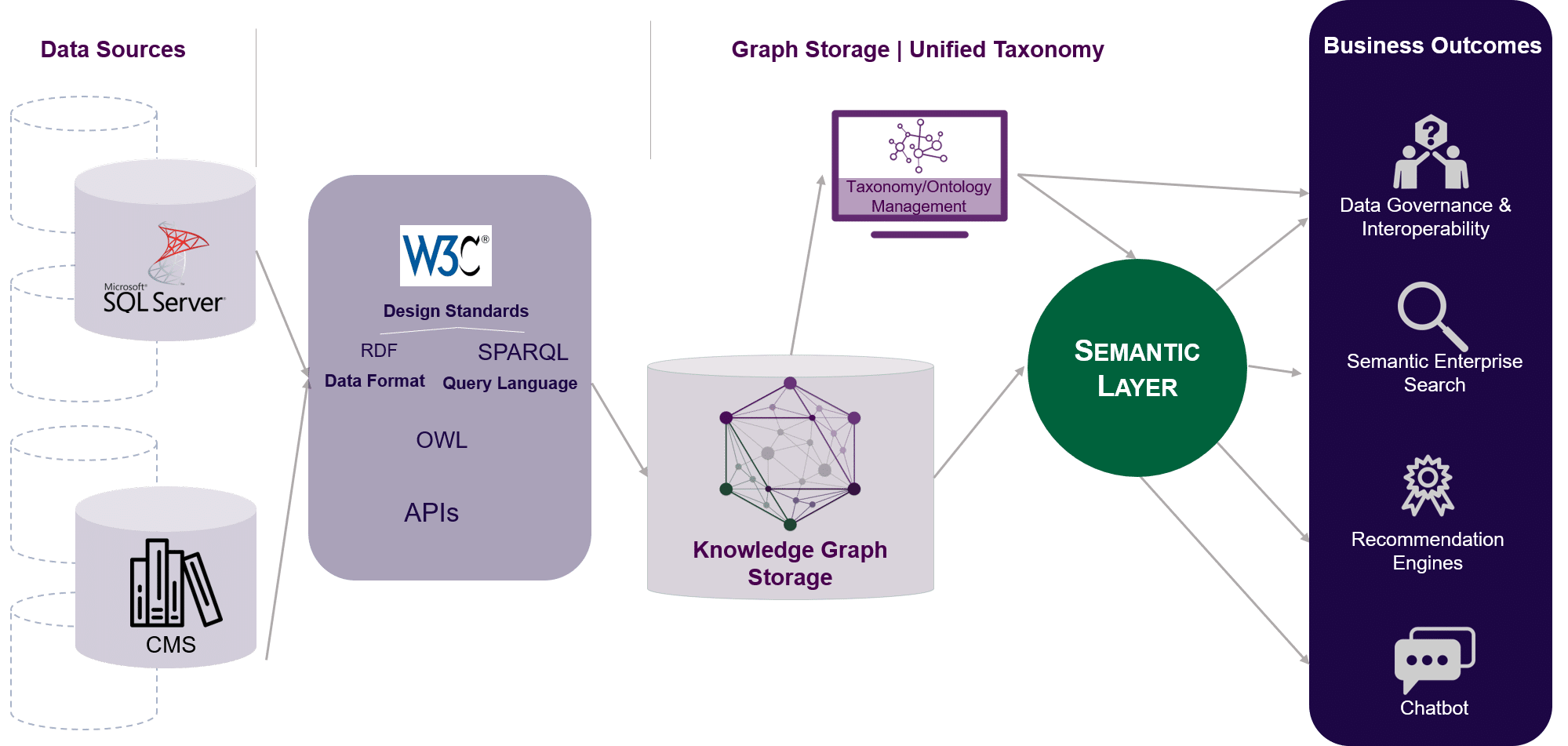Can you access the bulk of your organization’s data through simple search or navigation using common business terms? If so, your organization may be one of the few that is reaping the benefits of a semantic data layer. A semantic layer provides the enterprise with the flexibility to capture, store, and represent simple business terms and context as a layer sitting above complex data. This is why most of our clients typically give this architectural layer an internal nickname, referring to it as “The Brain,” “The Hub,” “The Network,” “Our Universe,” and so forth.
As such, before delving deep into the architecture, it is important to align on and understand what we mean by a semantic layer and its foundational ability to solve business and traditional data management challenges. In this article, I will share EK’s experience designing and building semantic data layers for the enterprise, the key considerations and potential challenges to look out for, and also outline effective practices to optimize, scale, and gain the utmost business value a semantic model provides to an organization.
What is a Semantic Layer?
A semantic layer is not a single platform or application, but rather the realization or actualization of a semantic approach to solving business problems by managing data in a manner that is optimized for capturing business meaning and designing it for end user experience. At its core, a standard semantic layer is specifically comprised of at least one or more of the following semantic approaches:
- Ontology Model: defines the types of things that exist in your business domain and the properties that can be used to describe them. An ontology provides a flexible and standard model that organizes structured and unstructured information through entities, their properties, and the way they relate to one another.
- Enterprise Knowledge Graph: uses an ontology as a framework to add in real data and enable a standard representation of an organization’s knowledge domain and artifacts so that it is understood by both humans and machines. It is a collection of references to your organization’s knowledge assets, content, and data that leverages a data model to describe the people, places, and things and how they are related.
A semantic layer thus pulls in these flexible semantic models to allow your organization to map disparate data sources into a single schema or a unified data model that provides a business representation of enterprise data in a “whiteboardable” view, making large data accessible to both technical and nontechnical users. In other words, it provides a business view of complex knowledge, information, and data and their assorted relationships in a way that can be visually understood.
How Does a Semantic Layer Provide Business Value to Your Organization?
Organizations have been successfully utilizing data lakes and data warehouses in order to unify enterprise data in a shared space. A semantic data layer delivers the best value for enterprises that are looking to support the growing consumers of big data, business users, by adding the “meaning” or “business knowledge” behind their data as an additional layer of abstraction or as a bridge between complex data assets and front-end applications such as enterprise search, business analytics and BI dashboards, chatbots, natural language process etc. For instance, if you ask a non-semantic chatbot, “what is our profit?” and it recites the definition of “profit” from the dictionary, it does not have a semantic understanding or context of your business language and what you mean by “our profit.” A chatbot built on a semantic layer would instead respond with something like a list of revenue generated per year and the respective percentage of your organization’s profit margins.
With a semantic layer as part of an organization’s Enterprise Architecture (EA), the enterprise will be able to realize the following key business benefits:
- Bringing Business Users Closer to Data: business users and leadership are closer to data and can independently derive meaningful information and facts to gain insights from large data sources without the technical skills required to query, cleanup, and transform large data.
- Data Processing: greater flexibility to quickly modify and improve data flows in a way that is aligned to business needs and the ability to support future business questions and needs that are currently unknown (by traversing your knowledge graph in real time).
- Data Governance: unification and interoperability of data across the enterprise minimizes the risk and cost associated with migration or duplication efforts to analyze the relationships between various data sources.
- Machine Learning (ML) and Artificial Intelligence (AI): Serves as the source of truth for providing definition of the business data to machines and enabling the foundation for deep learning and analytics to help the business answer or predict business challenges.
Building the Architecture of a Semantic Layer
A semantic layer consists of a wide array of solutions, ranging from the organizational data itself, to data models that support object or context oriented design, semantic standards to guide machine understanding, as well as tools and technologies to enable and facilitate implementation and scale. 
The three foundational steps we have identified as critical to building a scalable semantic layer within your enterprise architecture are:
1. Define and prioritize your business needs: In building semantic enterprise solutions, clearly defined use cases provide the key question or business reason your semantic architecture will answer for the organization. This in turn drives an understanding of the users and stakeholders, articulates the business value or challenge the solution will solve for your organization, and enables the definition of measurable success criteria. Active SME engagement and validation to ensure proper representation of their business knowledge and understanding of their data is critical to success. Skipping this foundational step will result in missed opportunities for ensuring organizational alignment and return on your investment (ROI).
2. Map and model your relevant data: Many organizations we work with support a data architecture that is based on relational databases, data warehouses, and/or a wide range of content management cloud or hybrid cloud applications and systems that drive data analysis and analytics capabilities. This does not necessarily mean that these organizations need to start from scratch or overhaul their working enterprise architecture in order to adopt/implement semantic capabilities. For these organizations, it is more effective to start increasing the focus on data modeling and designing efforts by adding models and standards that will allow for capturing business meaning and context (see section below on Web Standards) in a manner that provides the least disruptive starting point. In such scenarios, we typically select the most effective approach to model data and map from source systems by employing the relevant transformation and unification processes (Extract, Transform, Load – ETLs) as well as model-mapping best practices (think ‘virtual model’ versus stored data model in graph storages like graph databases, property graphs, etc.) that are based on the organization’s use cases, enterprise architecture capabilities, staff skill sets, and primarily provide the highest flexibility for data governance and evolving business needs.
| The state of an organization’s data typically comes in various formats and from disparate sources. Start with a small use case and plan for an upfront clean-up and transformation effort that will serve as a good investment to start organizing your data and set stakeholder expectations while demonstrating the value of your model early. |
3. Leverage semantic web standards to ensure interoperability and governance: Despite the required agility to evolve data management practices, organizations need to think long term about scale and governance. Semantic Web Standards provide the fundamentals that enable you to adopt standard frameworks and practices when kicking off or advancing your semantic architecture. The most relevant standards to the enterprise should be to:
- Employ an established data description framework to add business context to your data to enable human understanding and natural language meaning of data (think taxonomies, data catalogs, and metadata);
- Use standard approaches to manage and share the data through core data representation formats and a set of rules for formalizing data to ensure your data is both human-readable and machine-readable (examples include XML/RDF formats);
- Apply a flexible logic or schema to map and represent relationships, knowledge, and hierarchies between your organization’s data (think ontologies/OWL);
- A semantic query language to access and analyze the data natural language and artificial intelligence systems (think SPARQL).
- Start with available existing/open-source semantic models and ecosystems for your organization to serve as a low-risk, high-value stepping stone (think Open Linked Data/Schema.org). For instance, organizations in the financial industry can start their journey by using a starter ontology for Financial Industry Business Ontology (FIBO), while we have used the Gene Ontology for Biopharma as a jumping off point or to enrich or tailor their model for the specific needs of their organization.
4. Scale with Semantic Tools: Semantic technology components in a more mature semantic layer include graph management applications that serve as middleware, powering the storage, processing, and retrieval of your semantic data. In most scaled enterprise implementations, the architecture for a semantic layer includes a graph database for storing the knowledge and relationships within your data (i.e. your ontology), an enterprise taxonomy/ontology management or a data cataloging tool for effective application and governance of your metadata on enterprise applications such as content management systems, and text analytics or extraction tools to support advanced capabilities such as Machine Learning (ML) or natural language processing (NLP) depending on the use cases you are working with.
5. “Plug in” your customer/employee facing applications: The most practical and scalable semantic architecture will successfully support upstream customers or employees facing applications such as enterprise search, data visualization tools, end services/consuming systems, and chatbots, just to name a few potential applications. This way you can “plug” semantic components into other enterprise solutions, applications, and services. With this as your foundation, your organization can now start taking advantage of advanced artificial intelligence (AI) capabilities such as knowledge/relationship and text extraction tools to enable Natural Language Processing (NLP), Machine Learning based pattern recognition to enhance findability and usability of your content, as well automated categorization of your content to augment your data governance practices.
| The cornerstone of a scalable semantic layer is ensuring the capability for controlling and managing versions, governance, and automation. Continuous integration pipelines including standardized APIs and automated ETL scripts should be considered as part of the DNA to ensure consistent connections for structured input from tested and validated sources. |
Conclusion
In summary, semantic layers work best as a natural integration framework for enabling interoperability of organizational information assets. It is important to get started by focusing on valuable business-centric use cases that drive getting into semantic solutions. Further, it is worth considering a semantic layer as a complement to other technologies, including relational databases, content management systems (CMS), and other front-end web applications that benefit from having easy access and an intuitive representation of your content and data including your enterprise search, data dashboards, and chatbots.
If you are interested in learning more to determine if a semantic model fits within your organization’s overall enterprise architecture or if you are embarking on the journey to bridge organizational silos and connect diverse domains of knowledge and data that accelerate enterprise AI capabilities, read more or email us.
| Get Started | Ask Us a Question |
